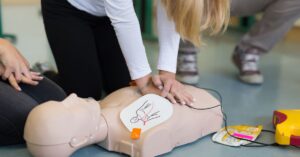A critical qualification for most healthcare professionals, a Basic Life Support (BLS) certification can also help anyone looking to prepare for the unexpected. When you pass the BLS certification exam, you demonstrate your ability to provide lifesaving care during medical emergencies.
Whether you’re a first-time test-taker or looking to renew your certification, follow these helpful tips for passing BLS certification exams to set yourself up for success.
1. Familiarize Yourself with the Exam Format
Understanding what to expect is half the battle. Typically, the BLS certification exam typically includes these two components:
- Written test: Questions on CPR (cardiopulmonary resuscitation), AED (automated external defibrillator) use, and basic airway management.
- Skills test: Performing effective chest compressions, proper AED application, and correct rescue breath techniques.
Now that you know the general structure of the exam, you can focus your preparation where it’s needed most.
2. Invest in a High-Quality Training Course
Choose a course accredited by the American Heart Association (AHA) or other reputable organizations. The programs at CPR123 provide comprehensive study materials including online tutorials, hands-on practice sessions, and step-by-step guidelines.
However, make sure your course includes practice tests, as these can replicate real exam conditions and boost your confidence.
3. Master Key BLS Skills
Preparation goes beyond memorization, so focus on accurately performing these skills:
- Performing 30 high-quality chest compressions at the right depth and speed
- Delivering two rescue breaths using a bag-mask device or pocket mask
- Applying the AED and guaranteeing all teammates understand your commands
Practice regularly to refine your muscle memory and improve speed under pressure.
4. Use Mnemonics To Remember CPR Steps
For critical steps, using mnemonics can simplify memorization. The acronym CAB is a great tool to help you remember the correct sequence of compressions, checking the airway, and monitoring breathing. With this helpful mnemonic device, you can effectively prioritize lifesaving tasks.
5. Take Practice Tests
Mock tests closely mirror the format of BLS certification exams and allow you to identify areas that may need improvement. For any answers you get incorrect, review the explanations and dedicate time to reviewing those specific concepts.
6. Prepare for Renewal in Advance
BLS certification typically lasts for two years, so make note of your renewal date in advance to avoid gaps in certification. BLS renewal courses often focus on updates in guidelines from the AHA, so stay current on best practices.
Now that you have some helpful tips for passing BLS certification exams, you’re prepared to conquer your upcoming exam and begin saving lives with confidence. If you’re ready to take the next step, enroll in an accredited BLS course at CPR123 and start practicing today.







